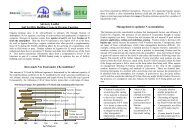Green Manures booklet - Institute of Organic Training and Advice
Green Manures booklet - Institute of Organic Training and Advice
Green Manures booklet - Institute of Organic Training and Advice
You also want an ePaper? Increase the reach of your titles
YUMPU automatically turns print PDFs into web optimized ePapers that Google loves.
2. Types <strong>of</strong> green manures<br />
Not all green manures will bring all the benefits listed in Section 1. Different green manuring strategies must be<br />
selected depending upon the main purpose for which they are being grown. A general description <strong>of</strong> green<br />
manure types is given here followed by more detail on each species. Unless otherwise stated, information was<br />
gathered from Suhr et al. (2005), NIAB (2005), Hally (1983) <strong>and</strong> unpublished work by HDRA. Varieties are<br />
given as examples only, <strong>and</strong> more detailed information on selecting varieties can be obtained from the NIAB<br />
Pocket Guide to Livestock Crops (2005). A practical guide to using these crops can also be obtained from the<br />
website <strong>of</strong> the DEFRA funded project, ‘The development <strong>of</strong> improved guidance on the use <strong>of</strong> fertility building<br />
crops in organic farming (OF 0316)’ (http://www.organicsoilfertility.co.uk/reports/docs/leaflet.pdf )<br />
Long term green manures. Leys, usually established for two or three years, are a basic part <strong>of</strong> many organic<br />
arable rotations. Where animals are present on the farm the leys would usually be grazed or cut for silage but in<br />
stockless systems they are normally cut monthly during the summer period <strong>and</strong> the mowings allowed to remain<br />
on the surface as a mulch. Such leys may be pure clover (when nitrogen fixation is a priority) or a grass/clover<br />
mixture (when organic matter build up is also important).<br />
Winter green manures are usually sown in the autumn <strong>and</strong> incorporated in the following spring. They can be a<br />
good way <strong>of</strong> fitting a fertility building crop into a rotation if they can utilise l<strong>and</strong> that would otherwise be bare.<br />
However, it can be difficult to establish them early enough to do any good if harvest <strong>of</strong> the preceding summer<br />
crop is delayed. They can be legumes (eg vetch) but a major use for this class <strong>of</strong> crops (even in conventional<br />
agriculture) is to minimise nitrogen leaching; when used for this purpose they are <strong>of</strong>ten called winter cover<br />
crops.<br />
Summer green manures are usually legumes grown to provide a boost <strong>of</strong> nitrogen in mid rotation. They may be<br />
grown for a whole season (say April to September) or for a shorter period between two cash crops. These<br />
shorter-term green manures can include non-legumes such as mustard <strong>and</strong> phacelia. They are sometimes referred<br />
to as catch crops but this term is rather misleading.<br />
<strong>Green</strong> manures may also be used in intercropping systems. On arable farms leys are usually established by<br />
undersowing them in the preceding cereal crop – this gives the green manure a longer growth period <strong>and</strong> can<br />
help in weed control. A similar thing can be done with horticultural crops but care is needed to avoid too much<br />
competition. The practice may be particularly valuable as a pest control measure.<br />
Protected cropping systems <strong>of</strong>fer particular challenges <strong>and</strong> opportunities for green manuring. Because <strong>of</strong> the<br />
warmer temperatures it may be possible to sow ‘summer’ green manures at any time <strong>of</strong> year but trial <strong>and</strong> error<br />
would be needed to fit them in to the particular cropping plan <strong>of</strong> an individual grower.<br />
Fertility building in orchards is particularly difficult because nitrogen must be provided at the right time to<br />
ensure good fruit set <strong>and</strong> quality. <strong>Green</strong> manures grown as an understory can also play an important role in<br />
attracting beneficial insects <strong>and</strong> management decisions to achieve these twin goals must be carefully integrated.<br />
Similar issues also apply in other long term cropping situations (eg asparagus production).<br />
A wide variety <strong>of</strong> plants can be used as green manures in different situations <strong>and</strong> the list below is not exhaustive.<br />
General characteristics for suitability might include cheapness <strong>of</strong> seed, rapid germination <strong>and</strong> growth,<br />
competitiveness with weeds, ability to grow in nutrient-poor soil, ease <strong>of</strong> incorporation <strong>and</strong> unlikeliness to return<br />
as a weed in the next crop. The basic division is into legumes <strong>and</strong> non-legumes. Some species (especially red<br />
<strong>and</strong> white clover) have been highly bred to provide particular characteristics as forage crops <strong>and</strong> for these there<br />
is a wide choice <strong>of</strong> cultivars. In other cases there may be no choice <strong>of</strong> variety at all. It may be difficult to get hold<br />
<strong>of</strong> the seed <strong>of</strong> some crops but they are listed below as they may be beneficial in particular situations. Many <strong>of</strong> the<br />
crops are known by a range <strong>of</strong> common names <strong>and</strong> this can result in considerable confusion.<br />
The use <strong>of</strong> green manures<br />
4




